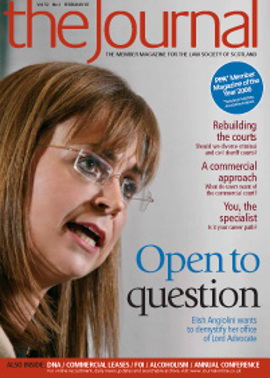Working out time

Grossing up time on remand
Regardless of what the Act actually says about what sentencers have to say about discounts, it is clear now that what the appeal court expects is a “You would have got X but for such and such, which entitles you to a discount of Y, resulting in a sentence of Z.” Among the various considerations to be factored in has always been, and continues to be, the time already spent in custody on remand.
A question has sometimes arisen, however, as to whether this time should be grossed up, as it were, to reach a figure that would represent what the time on remand would have meant if it had been the portion-to-be-served of a substantive sentence. In other words, it was quite common for agents to say that such and such a time had been spent in custody, which allowing for remission would represent such and such a substantive sentence. (How this will be affected by new proposals about remission is, on the basis that a problem shelved is a problem solved, for another day.)
Anyway, the situation has been put beyond doubt by Martin v HMA [2006] HCJAC 86; 2006 GWD 37-740. The court acknowledged that time on remand was different from a period spent in custody, but pointed out that both involved loss of liberty. Accordingly there fell to be deducted from the sentence which would otherwise be imposed (special circumstances being absent) not just the period itself, but the length of sentence which would have resulted in that sentence being served in custody.
It would seem therefore that for anyone on remand for 40 days, say, on this basis they should not receive any custodial sentence unless it is of more than three months – I think. Another conceivable complication would seem to arise from the fact that if the court takes into account the time on remand in passing a sentence effective from the day it is imposed, then credit will be given for what, constructively, would as a sentence have resulted in that time in custody, whereas if the court simply backdates the sentence, credit will be given for the actual days served only, unless of course the court shortens the sentence pronounced to give effect to a larger number of days credited. The court cannot backdate the sentence when, as seems to be increasingly the case, the accused had been detained in custody for an early trial which in the event has been unable to go ahead, with the accused then eventually being released on bail.
Good character not relevant?
Another sentencing appeal, referred, unusually perhaps, by the Scottish Criminal Cases Review Commission, is dealt with in Baillie v HMA [2006] HCJAC 91; 2006 GWD 40-777. In this case a doctor had been sentenced to nine years’ imprisonment, discounted from 12, in respect of a guilty plea to 17 charges of assault against female patients involving acts of indecency including, inter alia, unnecessary internal examinations. The court held that the starting point of 12 years was excessive, there being no penile penetration or physical violence. Further, in setting the degree of severity of sentence it was not appropriate to include an element as a deterrent to any other health professional who might find himself similarly tempted. Balancing this exception, as it were, was the observation that in most cases of this sort the offender would be a person of otherwise good character so that no substantial reduction was to be expected in that regard.
The ramifications of this singling out of the medical community as one where character is universally so good as to be irrelevant and where temptation is so readily resisted as not to require the helping hand of deterrence may take some time to digest in full. In the meantime it would be interesting to know whether any other trades or professions feel entitled to recognition in similar terms.
Mixed statements
The term “mixed statement” is one with which we have become increasingly familiar over the years and involves, as will be known to many readers, a consideration of what use may be made by prosecution and defence, of an extrajudicial statement involving elements supporting, perhaps separately, both conviction and acquittal. The matter was considered again in the case of Clark v HMA [2006] HCJAC 92; 2006 GWD 40-776, where the appeal court took the view that no appropriate direction had been given to the jury as how they should deal with statements which were both incriminatory and exculpatory. The court also found that there had been a failure to give adequate directions on the subject of self-defence, and in particular that while the sheriff had referred to the directions given in the case of HMA v Doherty 1954 SLT 169, there had been a failure to give directions as to onus as specified in that case, and also as to the question of proportionality. It was also stated that the concepts of “credibility” and “reliability” are legal ones which few if any judges fail to define for a jury, and that in a case where there is a clear dispute about facts a direction about these concepts is clearly necessary.
Objections to admissibility…
The case of Britz v HMA [2006] HCJAC 90; 2006 GWD 40-774 is of interest, in that it sees the appeal court setting out what a judge should do at a first diet in solemn procedure in respect of a minute in terms of s 71(2) of the Criminal Procedure (Scotland) Act 1995, objecting to the admission of evidence from an identification parade alleged to have been conducted unfairly. The minute here had been repelled, but the appeal court allowed the appeal and remitted the matter back to proceed as accords. In so doing, the court set out the appropriate procedure as follows. When an issue of admissibility was so raised, either on grounds of procedural unfairness or for some other reason, it was for the judge to rule on that issue and that included resolving, so far as it could be done, any factual issues which might arise. If the evidence (or line of evidence) were held to be inadmissible, then it would follow that the jury heard nothing about it. On the other hand, if the evidence was held to be admissible, the jury would hear it but still would be entitled to take its own view about the circumstances in which the challenged evidence arose and consequentially, of what if any weight should be attached to it. It was held that the test for withholding evidence from a jury as set out in Howarth v HMA 1992 SCCR 364 no longer applied and Thompson v Crowe 2000 JC 173 was followed.
… and the test on appeal
In this connection, it is worth having a look at the unreported case of Jason Neil v HMA, decided on 20 October 2006. This was an appeal against a decision of a sheriff at a first diet to admit evidence from an interview in which the appellant may not have fully understood the common law caution. The appellant was described as being of limited intellectual ability and was aged 17 when interviewed in the presence of his mother by a police sergeant. At the first diet the sheriff heard evidence of the circumstances of the interview and also from a psychologist about the appellant’s capacity and understanding.
At the appeal it was accepted that the appropriate test was whether the sheriff’s decision was or was not manifestly unreasonable, being essentially one of fact. (See B v HMA 2003 SLT 662.) On that basis, the appeal court refused the appeal. It is also worth noting in this context that in Thompson v Crowe 2000 JC 173, followed in Platt v HMA 2004 SLT 333, it was accepted that the appropriate standard for a judge to apply in deciding an issue of admissibility was proof on the balance of probabilities. In other words it was for the Crown to prove on a balance of probability that the statement was fairly obtained.
Interest to invoke privilege
Greenan v HMA [2006] HCJAC 80; 2006 GWD 37-739 involves what may be a novel point (although the situation does crop up from time to time) about a witness’s right not to answer questions, which would involve self incrimination. The appellant was charged with producing cannabis and his defence involved the incrimination of his daughter, K. She was led as a defence witness and accepted responsibility. The appeal was on the basis that the presiding sheriff had required the witness to answer questions which she should not have had to answer, given her right not to incriminate herself. The appeal court held that, by virtue of having accepted responsibility for the cultivation of the cannabis, the witness had waived her right not to have to answer questions in respect of that responsibility. It was also observed by the court, rather significantly, that even if K had been directed to answer questions which she should not have been, this could not be the basis of any right of appeal, since the privilege against self incrimination was K’s alone, and was not a right which the appellant had any direct interest to enforce.
No direction required
Another situation which is both novel from the appeal point of view and reasonably common in trials is what directions the judge should give the jury in respect of a co-accused who pleads guilty and then is called as a prosecution witness. The short answer is, none. The danger of giving particular directions is that this will amount, in effect, to something very like a cum nota warning. Even when the evidence given seems to be at odds with the terms of the plea, as to which the judge may remind the jury, the matter is best covered by the general directions which will be given as regards the assessment of evidence and the importance of the tools of credibility and reliability.
In this issue
- Routes to qualification: the Italian picture
- Speaking of change
- Disabled from suing?
- Hearing and answering
- Court afresh
- Clean sheet at the Commercial Court
- Making a specialism pay
- LCN DNA - devil in the detail
- To buy or not to buy?
- Just a winter warmer?
- Views from the new boy
- Working out time
- A claim in trust
- Incapable of dismissal?
- Chasing debts made simple?
- Scottish Solicitors' Discipline Tribunal
- Website reviews
- Book reviews
- FOISA goes to court
- On the wrong track?






